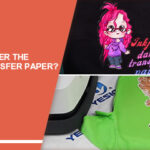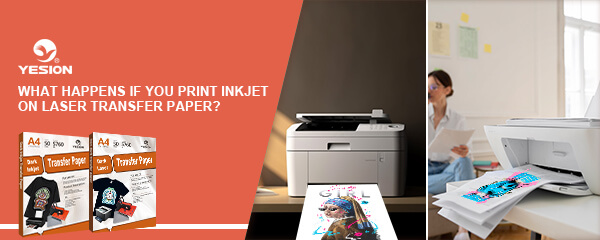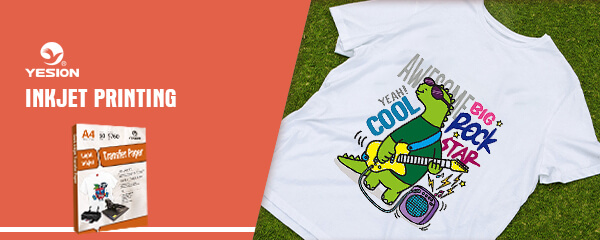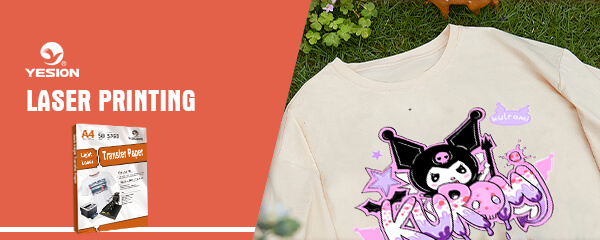
Is Heat Transfer Paper The Same As iron on transfer paper?
2024-01-16
Transfer paper: Is inkjet or laser better?
2024-01-23Embarking on the journey of printing is filled with choices, and one common question that arises is, “What happens if you print inkjet on laser transfer paper?” In this article, we will navigate through the intricacies, providing valuable insights to ensure your printing endeavors are successful.
Inkjet transfer paper is a specialized type of paper designed for use with inkjet printers to create high-quality transfers onto various surfaces. It offers several qualities that make it suitable for specific printing methods, making it the preferred choice for many printing tasks. Let’s explore the characteristics of inkjet transfer paper:
Coating: Inkjet transfer paper is coated with a special heat-activated polymer or wax layer. This coating allows the ink from the inkjet printer to be transferred onto the target material when heat and pressure are applied during the transfer process. The coating helps to ensure sharp and vibrant image reproduction, resulting in professional-looking transfers.
Compatibility: Inkjet transfer paper is specifically designed for use with inkjet printers. The inkjet printer uses liquid ink that is absorbed by the paper’s coating, allowing it to adhere effectively to the target material. Using inkjet transfer paper with other types of printers may lead to poor ink absorption and incomplete transfers.
Versatility: Inkjet transfer paper can be used on a wide range of materials, including fabrics, ceramics, wood, and more. This versatility allows for the creation of custom designs on various surfaces. It is particularly popular for creating personalized apparel, such as t-shirts, tote bags, and caps.
Image Quality: Inkjet transfer paper enables high-resolution and detailed image reproduction. Inkjet printers can produce sharp and vibrant prints, resulting in clear and accurate transferred designs. This makes inkjet transfer paper an excellent choice for transferring complex designs, photographs, or graphics onto various surfaces.
Easy to Use: Inkjet transfer paper is relatively easy to use, even for beginners. The process typically involves printing the desired design onto the transfer paper, applying heat and pressure to transfer the image onto the target material, and then peeling off the backing paper. The simplicity of the process makes inkjet transfer paper accessible for DIY projects and small-scale production.
Cost-effective: Inkjet transfer paper is generally more affordable compared to other transfer methods, such as screen printing or sublimation printing. This cost-effectiveness makes it a popular choice for small businesses, hobbyists, and individuals looking to create custom designs without investing in specialized equipment.
Laser Transfer Paper Properties
Laser transfer paper is a specialized type of paper designed for use with laser printers to create transfers onto various surfaces. It offers distinctive features that differentiate it from its inkjet counterpart. Let’s delve into the properties of laser transfer paper:
Toner Adhesion: Laser transfer paper is specifically designed to work with the toner used in laser printers. The toner consists of a dry powder that is fused onto the paper using heat. The surface of laser transfer paper facilitates strong adhesion of the toner, ensuring that the transferred design adheres firmly to the target material.
Heat Resistance: Laser transfer paper is designed to withstand the high temperatures generated by laser printers during the transfer process. The heat activates the toner particles, causing them to bond with the target material. This heat resistance allows for durable and long-lasting transfers, especially when applied to fabrics.
Versatility: Laser transfer paper can be used to transfer designs onto various materials, including fabrics, ceramics, metals, and more. The transferred design can withstand washing, making it suitable for creating personalized apparel, promotional items, and customized crafts.
Image Clarity: Laser transfer paper enables high-resolution and detailed image reproduction. Laser printers can produce sharp and precise prints, resulting in clear and vibrant transferred designs. This makes laser transfer paper suitable for intricate or complex designs that require fine details.
Compatibility: Laser transfer paper is specifically designed for use with laser printers. The toner used in laser printers is fused onto the paper using heat, creating a durable and long-lasting transfer. Using laser transfer paper with inkjet printers may lead to poor adhesion, smudging, or incomplete transfers.
What Happens if You Print Inkjet on Laser Transfer Paper?
When printing inkjet on laser transfer paper, it can lead to unsatisfactory results and may not achieve the desired outcome. Here are a few reasons why printing inkjet on laser transfer paper may not produce the desired results:
Ink Compatibility: Inkjet printers use liquid ink, while laser transfer paper is designed to work with toner, which is a dry powder. The ink from an inkjet printer may not adhere properly to the surface of the transfer paper, leading to smudging, poor image quality, or incomplete transfer of the design onto the target material.
Heat Resistance: Laser transfer paper is engineered to withstand the high temperatures generated by laser printers during the transfer process. Inkjet ink, however, is typically not designed to withstand such high temperatures. Consequently, when heat is applied to the paper during the transfer process, the inkjet ink may not hold up well, resulting in blurred or distorted images.
Image Quality: Laser transfer paper is optimized for use with laser printers, which can produce high-resolution prints with sharp details. Inkjet printers, while capable of producing high-quality prints, may not deliver the same level of sharpness and clarity when used with laser transfer paper. The results may appear less vibrant or have reduced color accuracy.
Durability: Laser transfer paper is designed to create durable and long-lasting transfers, especially when applied to fabrics. The toner used in laser printers has excellent adhesion properties, allowing the design to adhere firmly to the material. Inkjet ink may not adhere as strongly to the transfer paper or the target material, resulting in diminished durability and the design fading or washing out over time.
To achieve the best results when using laser transfer paper, it is recommended to use a laser printer specifically designed for this purpose. Laser printers provide the necessary heat and toner adhesion to create high-quality and durable transfers. If you only have access to an inkjet printer, it is advisable to use transfer paper specifically designed for inkjet printers to ensure compatibility and optimal results.



